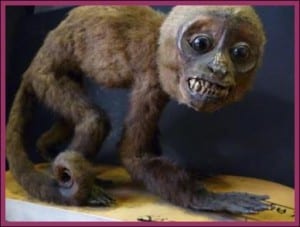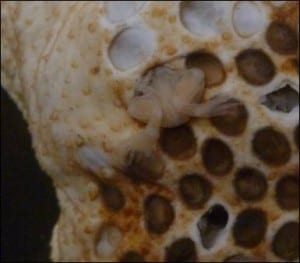Specimen of the Week: Week Fifty-One
By Emma-Louise Nicholls, on 1 October 2012
 As a zoologist there is nothing in the natural world that creeps me out. The word anus became part of my everyday vocabulary when teaching undergraduates comparative anatomy and I have dealt first-hand with plenty of what comes out of the anus throughout my years of animal encounters. I used to let my pet snails, which are slugs with better real estate, crawl all over me and there isn’t a creepy-crawly in the world that I would shy away from. However, there is one thing, one animal, one bizarre twist of evolution, which leaves me with a wrinkled nose and squinted eyes as I try to blur the vision in front of me into a more suitably unrecognisable smoosh of distant colours. But, not being one to be prejudice against gross things, you now get to share in my experience. This week’s Specimen of the Week is…
As a zoologist there is nothing in the natural world that creeps me out. The word anus became part of my everyday vocabulary when teaching undergraduates comparative anatomy and I have dealt first-hand with plenty of what comes out of the anus throughout my years of animal encounters. I used to let my pet snails, which are slugs with better real estate, crawl all over me and there isn’t a creepy-crawly in the world that I would shy away from. However, there is one thing, one animal, one bizarre twist of evolution, which leaves me with a wrinkled nose and squinted eyes as I try to blur the vision in front of me into a more suitably unrecognisable smoosh of distant colours. But, not being one to be prejudice against gross things, you now get to share in my experience. This week’s Specimen of the Week is…
**!!The Surinam Toad!!**
1) The Surinam toad has a distinctive triangular head. The nostrils stick out front giving it the look of an overgrown insect from more than one unflattering angle. The Surinam toad has brown or olive-green skin and a flattened body covered by a number of attractive tubercles. Like a bodybuilder that only works out one half of his body, the limbs are disproportionate. The back legs are strong and large, whilst the front are weak and would look more at home on a daddy longlegs than an Olympic athlete.
2) Unlike a number of toad species, the Surinam toad is an aquatic species. As if slightly cautious that its spindly front legs might collapse under its weight if it tries to flee from a predator on land, the Surinam toad rarely ventures out of the water. Rather, it chooses to spend its days hanging out, hidden under submerged leaf litter in ponds, pools, the backwaters of streams, or in slow flowing watercourses.
3) Fortunately for the Surinam toad, though less fortunately for squeamish South Americans, this species inhabits a far wider range than just the small but beautiful country of Suriname after which it is named. It occurs throughout much of the Amazon Basin and can be found from Colombia in the west all the way over to the east coast, and down as far as Bolivia. This toad has also popped up on several islands within Trinidad and Tobago. Though whilst an image of a toad with a pack on its back and a map in its hand is endearing, I doubt it would have survived such a long distance swim in saltwater. They are most likely to have been introduced by humans.
4) So why do I find this toad so unfortunately nauseating? Upon first glance, with its webbed back feet and mucus covered skin, it resembles your average toad. But what is this? Flip the toad over and it is covered in small dark holes many of which have blobs of near-translucent matter erupting from them. No, not a bad case of pustulating warts, these tiny masses are froglets, erupting from the mother’s back where they have been safely incubating for between three and four months. Whether that is more or less gross I shall leave you to consider. The male attached fertilised eggs to the females back which become enclosed by skin. When the young finally appear, they are fully metamorphosed into small versions of the adult form, rather than tadpoles. I invite you to watch a video of this in action and then come and see our specimen in which the froglets have been preserved mid-eruption. Yum.
5) The Surinam toad belongs to the family Pipidae, the common name for which is ‘tongue-less frogs’. So instead of launching a giant tongue out of its head at a million miles an hour to catch flies, the Surinam toad uses star-shaped organs located on its fingertips. Once these sensitive organs have detected its invertebrate prey, the toad enthusiastically lunges forward to grab it. More than making up for its lack of tongue.
Emma-Louise Nicholls is the Museum Assistant at the Grant Museum of Zoology
3 Responses to “Specimen of the Week: Week Fifty-One”
- 1
-
2
Knowledge is Power | Why Do So Many People Have a Fear of Holes? wrote on 10 June 2016:

[…] irrational fear of hole clusters—only grew worse. A nature show featuring the Surinam toad, a harmless little amphibian who carries her babies on her back, would escalate this fear. Seed […]
-
3
Ingrid Coulter wrote on 15 November 2018:
These creatures are like a train wreck, I cannot look away even though the HOLES GIVE ME THE HEEBEEJEBEES!! I think it has gotten my attention for about the last month. Nothing has gotten my attention like this in a very very long time, I must admit.
 Close
Close





I will agree with you on this one about the one specimen that makes me feel queeezzy, just thinking about this lil fella put me off my food for ages… scrolling down a bit further after reading the first part of this artical the thoughts came flooding back as i didn’t know what animal you might be refurrrrring to ha… now i will have to block it out again…
Love visiting the Grant Museum, you chaps rule!
Thankyou